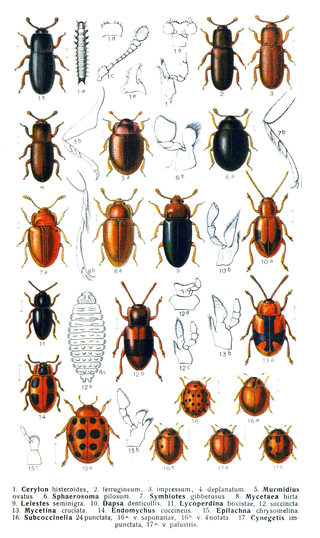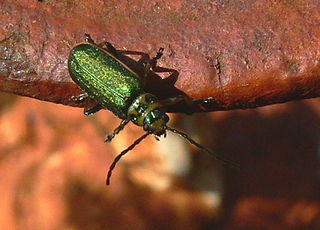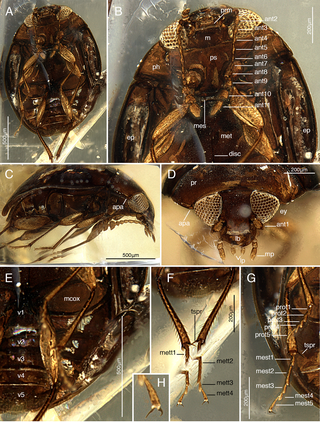
Scydmaeninae are a subfamily of small beetles, commonly called ant-like stone beetles or scydmaenines. These beetles occur worldwide, and the subfamily includes some 4,500 species in about 80 genera. Established as a family, they were reduced in status to a subfamily of Staphylinidae in 2009

Cucujoidea is a superfamily of beetles. This group formerly included all of the families now included in the superfamily Coccinelloidea. They include some fungus beetles and a diversity of lineages of "bark beetles" unrelated to the "true" bark beetles (Scolytinae), which are weevils.

Zopheridae is a family of beetles belonging to Tenebrionoidea. It has grown considerably in recent years as the members of two other families have been included within its circumscription; these former families are the Monommatidae and the Colydiidae, which are now both included in the Zopheridae as subfamilies or even as tribe of subfamily Zopherinae. Some authors accept up to six subfamilies here, while others merge all except the Colydiinae into the Zopherinae.

The Cerophytidae are a family of beetles belonging to Elateroidea. Larvae are associated with rotting wood, on which they are presumed to feed. The family contains over 20 species in five genera, primarily distributed in the New World, but also in Eurasia and Africa. 17 fossil species in 7 genera are known extending to the Early Jurassic. Like some other elateroids, the adults are capable of clicking.

Latridiidae is a family of tiny, little-known beetles commonly called minute brown scavenger beetles or fungus beetles. The number of described species currently stands at around 1050 in 29 genera but the number of species is undoubtedly much higher than this and increases each time a new estimate is made.

Cryptophagus is a genus of beetles in the family Cryptophagidae, the silken fungus beetles. It is distributed across all the biogeographic realms of the world. Like most of the other beetles in the family, these are fungivores, feeding on fungal spores and hyphae.

The Galerucinae are a large subfamily of the leaf beetles (Chrysomelidae), containing about 15,000 species in more than 1000 genera, of which about 500 genera and about 8000 species make up the flea beetle tribe Alticini.

Erotylidae, or the pleasing fungus beetles, is a family of beetles belonging to Cucujoidea containing over 100 genera. In the present circumscription, it contains 6 tribes and 10 subfamilies. In other words, the narrowly circumscribed Erotylidae correspond to the subfamily Erotylinae in the definition sensu lato. There are doubts on the monophyly of lower ranked taxa within Erotylidae, with further phylogenetic studies requiring better sampling and studies of unexplored character sets, for example the metendosternite and penile flagellum, which are generally lacking detailed morphological studies within the Coleoptera literature. The Eroytlina taxonomy is based on traits such as their different colors and not off morphological differences like mouthparts, thorax, and abdominal terminalia (Pecci-Maddalena).

Biphyllidae, or false skin beetles, are a family of beetles, in the superfamily Cleroidea. They have a cosmopolitan distribution. About 195 species are known. They live under the bark of dead trees and in leaf litter, and are mycophagous, feeding on fungi.

Monotomidae is a family of beetles in the superfamily Cucujoidea. The family is found worldwide, with approximately 240 species in 33 genera. The ecological habits of the family are diverse, with different members of the group being found under tree bark, in decaying vegetation, on flowers and in ant nests. Their ecology is obscure, while at least some species are mycophagous, feeding on the fruiting bodies of ascomycete fungi, Rhyzophagus are predators on bark beetles and possibly Phoridae larvae, with the larvae of some species also being mycophagous.

Antherophagus is a genus of silken fungus beetles in the family Cryptophagidae. There are at least four described species in Antherophagus.

Cryptophagini is a tribe of silken fungus beetles in the family Cryptophagidae. There are about 8 genera and at least 60 described species in Cryptophagini.

Atomariinae is a subfamily of silken fungus beetles in the family Cryptophagidae. There are about 8 genera and more than 170 described species in Atomariinae.

Cryptophaginae is a subfamily of silken fungus beetles in the family Cryptophagidae. There are about 11 genera and more than 180 described species in Cryptophaginae.

Atomariini is a tribe of silken fungus beetles in the family Cryptophagidae. There are about 5 genera and at least 70 described species in Atomariini.
Henotiderus is a genus of silken fungus beetles in the family Cryptophagidae. There are at least four described species in Henotiderus.

Caenoscelis is a genus of silken fungus beetles in the family Cryptophagidae. There are about 19 described species in Caenoscelis.
Micromyinae is a subfamily of wood midges, insects in the family Cecidomyiidae. Its members were formerly included in subfamily Lestremiinae. There are at least 55 genera and more than 650 described species in Micromyinae. All species in this subfamily are mycophageous.
Renodesta is a genus of silken fungus beetles in the family Cryptophagidae. There are at least two described species in Renodesta.

Cyclaxyridae are a family of beetles in the superfamily Cucujoidea. The only living genus is Cyclaxyra, with two species endemic to New Zealand. Other species have been named from fossils. They are also known as sooty mould beetles due to the association of Cyclaxyra with sooty mould. The extant species are mycophagous, feeding on spores, conidia, and hyphae.

















